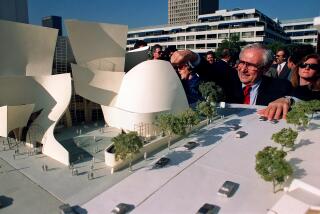Disney Hall Fund-Raisers, Designer Gehry in Conflict
- Share via
In the midst of a fund-raising boom that has breathed new life into downtown’s Walt Disney Concert Hall project, conflict has arisen between fund-raising leaders of the proposed home for the Los Angeles Philharmonic and its architect, Frank O. Gehry, over how the design and construction of the building should proceed.
Gehry--whose critically praised, undulating design was chosen in a highly touted competition in 1988--on Friday faxed a letter to Eli Broad, co-chairman of fund-raising for the hall, stating the architect’s intention of withdrawing from any further work on the project. Copies were sent to all Disney Hall fund-raisers, Music Center officials and a number of arts leaders.
By Monday, Gehry had softened his position somewhat. Speaking from Bilbao, Spain, where he is overseeing completion of his acclaimed Guggenheim Museum Bilbao, he said that although he has not yet walked off the project, “I am willing to leave if I am an obstruction to their process, with which I do not agree. . . . I am willing to leave so my feelings don’t get in the way.”
Disney Hall officials say they will meet with Gehry on Thursday, when he is scheduled to return from Spain. They say the dispute is no more than part of the debate that might be expected to occur on such a large and complex project.
Gehry’s conflict with project leaders comes on the heels of a flurry of corporate gifts and personal donations that have netted the project more than $60 million in new funds since December. The architect’s concern is that he maintain a strong role in the completion of the design details, which he says are only 75% done. The Disney Hall team, headed by Broad and Los Angeles Mayor Richard Riordan, has suggested that the design could be finalized by another architectural firm, with Gehry serving as a consultant.
Even if Gehry were to walk off the project today, the architect’s existing plan for Disney Hall legally could still be used, because the Disney Hall committee owns his designs to date. Riordan insisted Monday that, Gehry or no Gehry, the project will move forward.
“You know, Frank is a close friend of mine; we play ice hockey together,” Riordan said, “and I think he is the greatest architect in the world and has designed the greatest music hall in the world, and it is obviously disappointing that he has resigned. But the job now is to hopefully get Frank back to work, but no matter what, to get this magnificent structure built.
“Absolutely, he has done all the design work, and now it’s up to us to get it built. For the good of the structure, I hope it will be [with his cooperation], but it will be a great structure no matter what. We have to keep an eye on the goal.”
Gehry’s letter showed the architect’s distress over a project that seemed to be slipping out of his hands. Gehry compared turning incomplete work over to another firm to having someone who doesn’t speak French try to translate a French novel.
“The past few years have been difficult for me as I have taken a lot of heat for what has happened,” Gehry wrote, referring to a project that just over six months ago looked like it would never be built. Construction of the project was shut down in 1995 after spiraling cost estimates raised the price of the building to $265 million, from the original estimate of about $110 million.
“It has weighed heavily on my mind. This project has a life of its own and my opinions and my personal needs are secondary in the end,” Gehry continued. “Please forgive me as I withdraw myself from any future relationship to this project.”
Gehry said Monday that the suggestion that the remaining design work could be done by contractors in a “design / build” process would result in a compromised building. He also said that relying heavily on working drawings done between 1989 and 1994 by Dworsky Associates might save money in the short run but could result in cost overruns of as much as $30 million.
“Frank [Gehry] was engaged in 1989, and successfully completed his design contract with a superb result,” said Broad, a former developer who is now chairman and chief executive of SunAmerica Inc. “We have already stated that there will be no changes to his design. The integrity of the design and the quality of the building are our highest priorities.”
Although only rumors of conflict between Broad and Gehry have emerged since Broad took over the project last summer, a history of tension on Gehry’s part dates back to when Broad hired the architect to design his own residence in Brentwood. After disagreeing on how the project should be completed, Gehry left the project and Broad eventually hired another architect to complete the house. Broad says that the process was routine and finished to his satisfaction.
Gehry recalled that history in his letter: “Some people have said that 75% of my building is better than none. That’s the way you did your house, and you are satisfied. Maybe you can do it again. My obligation to myself and to the Disney family makes it impossible for me to agree to such a process.”
A chorus of Gehry supporters spoke out on his behalf Monday, saying his involvement is essential to the project. Among them was Diane Disney Miller--whose mother, Lillian B. Disney, Walt Disney’s widow, instigated the project with a 1987 gift of $50 million. Miller said the design could be seriously compromised if Gehry pulls out. The contribution of the Disney family to date has reached nearly $100 million.
Saying that she has confidence the conflict will be resolved and that she does not know the details of Gehry’s objections, Miller said: “God knows, it’s [Gehry’s] project; he sees things I think nobody else can, because he has been there from the very beginning.
“I am hoping that there will not be a confrontation; it may not be at the confrontation stage now,” she continued. “Eli [Broad] is a very wise and rational man. But Frank has drawn a line in the sand, and he has strong concerns, and in all honesty, I do, too.
“I’ll never forget that terrible meeting [in 1994] when we were told that the price [estimates for the hall] had doubled, that there wasn’t nearly enough money in my mother’s original gift to even think of completing the hall, and then to learn that so much work that had already been done was unusable. The idea that we could go down that same road again makes me very fearful and depressed. We are at a crossroads.”
Richard Weinstein, a UCLA professor of architecture and urban design who was on the competition committee that chose the Gehry model, described the situation as extremely delicate but still solvable.
That Gehry composed such a strong letter shows that “something very, very serious is going on and that the reputation of the city and region, not to mention the leadership of the cultural community is on the line,” said Weinstein. He was among those who received Gehry’s letter.
Philharmonic Managing Director Ernest Fleischmann also spoke in support of Gehry: “I think the project is so special and so unusual that without [Gehry’s] total involvement I would be very worried about the building.”
More to Read
The biggest entertainment stories
Get our big stories about Hollywood, film, television, music, arts, culture and more right in your inbox as soon as they publish.
You may occasionally receive promotional content from the Los Angeles Times.











